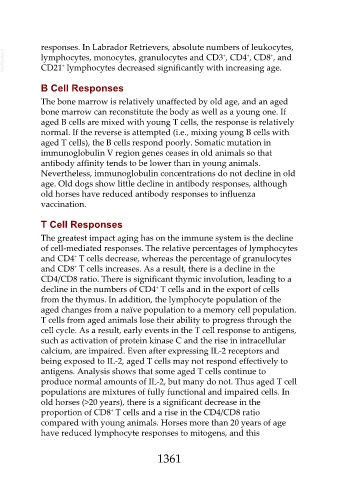Page 1361 - Veterinary Immunology, 10th Edition
P. 1361
responses. In Labrador Retrievers, absolute numbers of leukocytes,
VetBooks.ir lymphocytes, monocytes, granulocytes and CD3 , CD4 , CD8 , and
+
+
+
+
CD21 lymphocytes decreased significantly with increasing age.
B Cell Responses
The bone marrow is relatively unaffected by old age, and an aged
bone marrow can reconstitute the body as well as a young one. If
aged B cells are mixed with young T cells, the response is relatively
normal. If the reverse is attempted (i.e., mixing young B cells with
aged T cells), the B cells respond poorly. Somatic mutation in
immunoglobulin V region genes ceases in old animals so that
antibody affinity tends to be lower than in young animals.
Nevertheless, immunoglobulin concentrations do not decline in old
age. Old dogs show little decline in antibody responses, although
old horses have reduced antibody responses to influenza
vaccination.
T Cell Responses
The greatest impact aging has on the immune system is the decline
of cell-mediated responses. The relative percentages of lymphocytes
+
and CD4 T cells decrease, whereas the percentage of granulocytes
+
and CD8 T cells increases. As a result, there is a decline in the
CD4/CD8 ratio. There is significant thymic involution, leading to a
+
decline in the numbers of CD4 T cells and in the export of cells
from the thymus. In addition, the lymphocyte population of the
aged changes from a naïve population to a memory cell population.
T cells from aged animals lose their ability to progress through the
cell cycle. As a result, early events in the T cell response to antigens,
such as activation of protein kinase C and the rise in intracellular
calcium, are impaired. Even after expressing IL-2 receptors and
being exposed to IL-2, aged T cells may not respond effectively to
antigens. Analysis shows that some aged T cells continue to
produce normal amounts of IL-2, but many do not. Thus aged T cell
populations are mixtures of fully functional and impaired cells. In
old horses (>20 years), there is a significant decrease in the
+
proportion of CD8 T cells and a rise in the CD4/CD8 ratio
compared with young animals. Horses more than 20 years of age
have reduced lymphocyte responses to mitogens, and this
1361

